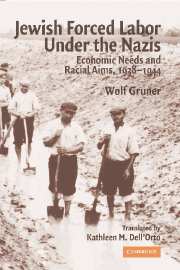Book contents
- Frontmatter
- Contents
- Abbreviations
- Introduction
- Prologue: Anti-Jewish Policies in the Nazi State before 1938
- GERMANY
- 1 Segregated Labor Deployment – Central Planning and Local Practice, 1938–1945
- 2 German Jews in Forced Labor Camps, 1939–1943
- 3 “Special Service” – Forced Labor of Jewish Mischlinge, 1942–1945
- AUSTRIA
- THE PROTECTORATE OF BOHEMIA AND MORAVIA
- THE OCCUPIED TERRITORIES OF POLAND
- Conclusion
- Index of Subjects
- Index of Persons
- Index of Places and Camps
1 - Segregated Labor Deployment – Central Planning and Local Practice, 1938–1945
Published online by Cambridge University Press: 05 June 2012
- Frontmatter
- Contents
- Abbreviations
- Introduction
- Prologue: Anti-Jewish Policies in the Nazi State before 1938
- GERMANY
- 1 Segregated Labor Deployment – Central Planning and Local Practice, 1938–1945
- 2 German Jews in Forced Labor Camps, 1939–1943
- 3 “Special Service” – Forced Labor of Jewish Mischlinge, 1942–1945
- AUSTRIA
- THE PROTECTORATE OF BOHEMIA AND MORAVIA
- THE OCCUPIED TERRITORIES OF POLAND
- Conclusion
- Index of Subjects
- Index of Persons
- Index of Places and Camps
Summary
PERSECUTORY POLICY IN 1938 AND INITIAL PLANS FOR FORCED LABOR
Historical researchers and the public still usually associate forced labor by German Jews in the Nazi period with work in concentration camps, or sometimes with assignment to industrial enterprises shortly before deportation. The fact that forced labor had already functioned as an integral component of anti-Jewish policy since 1938 was scarcely known until recently. In the concepts and plans for persecution of Jews developed after 1933 by leading Nazis, there was initially no reference to forced labor. The foremost objective was rapid and complete expulsion of Jewish Germans from Germany. However, with the Anschluss, 200,000 additional Jews came under German rule. At the same time, obstacles to mass emigration proliferated. The greater the number of persecutory measures introduced, the deeper the Jews sank into poverty. Without financial means, leaving remained illusory for most Jews. At the same time, willingness abroad to accept refugees diminished. It dawned on the Nazi leadership that their goal of expelling all Jews could no longer be attained with the methods used before.
Thus, ideas about forced labor first evolved primarily as a spontaneous means of exerting pressure to force departure, then later as a planned element of the changed persecutory policy. At the end of May 1938, for example, Hitler demanded that “asocial and criminal Jews” be arrested to “perform important excavation work throughout the Reich.” Whether this was intended as a real work project or not is difficult to assess.
- Type
- Chapter
- Information
- Jewish Forced Labor under the NazisEconomic Needs and Racial Aims, 1938–1944, pp. 3 - 31Publisher: Cambridge University PressPrint publication year: 2006



